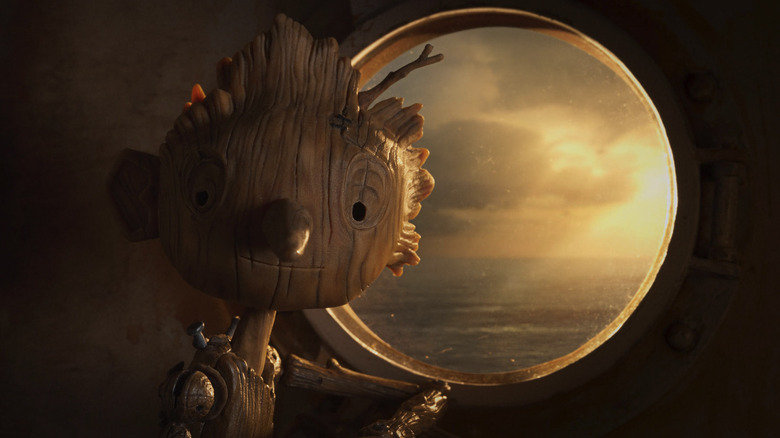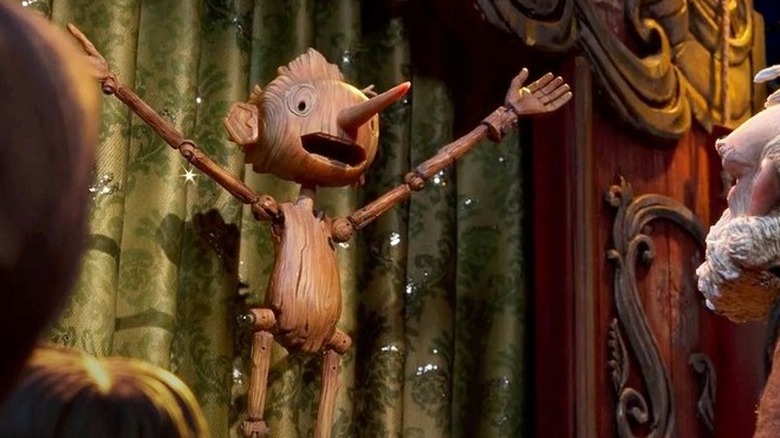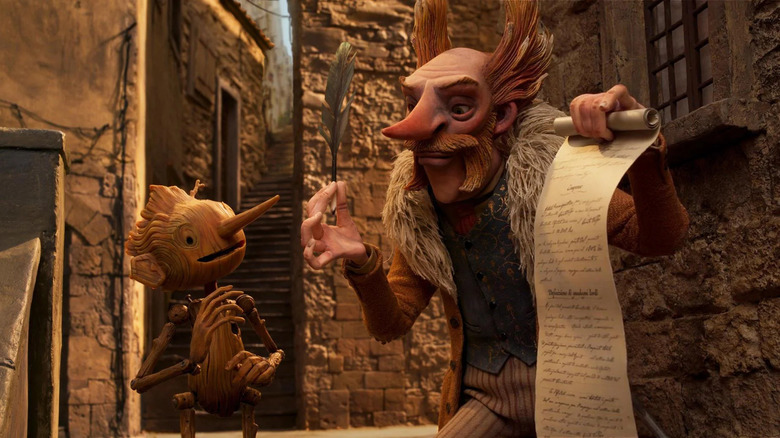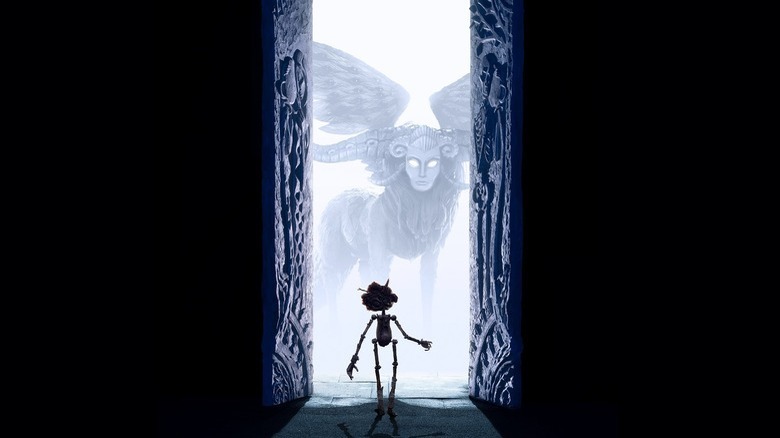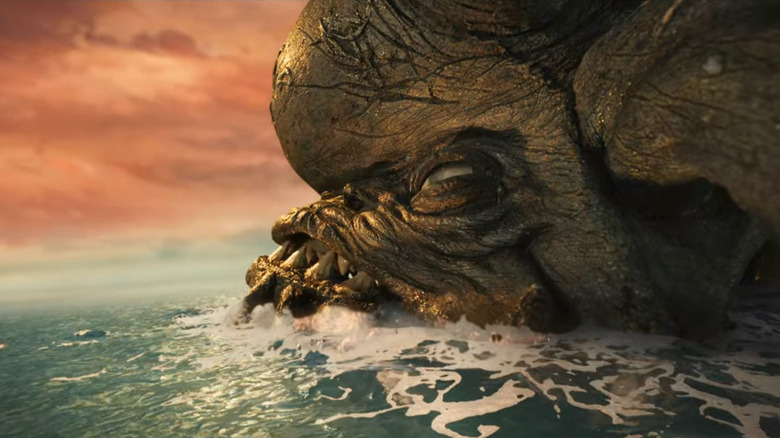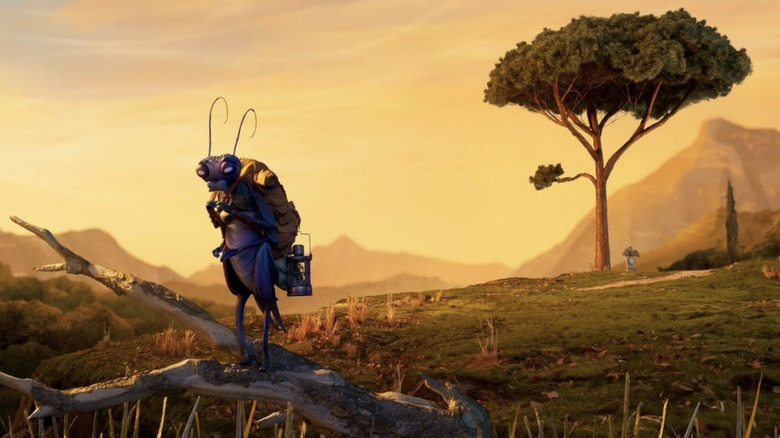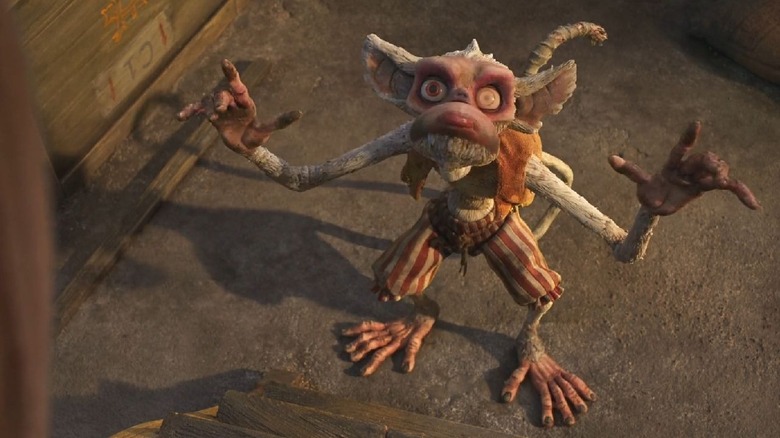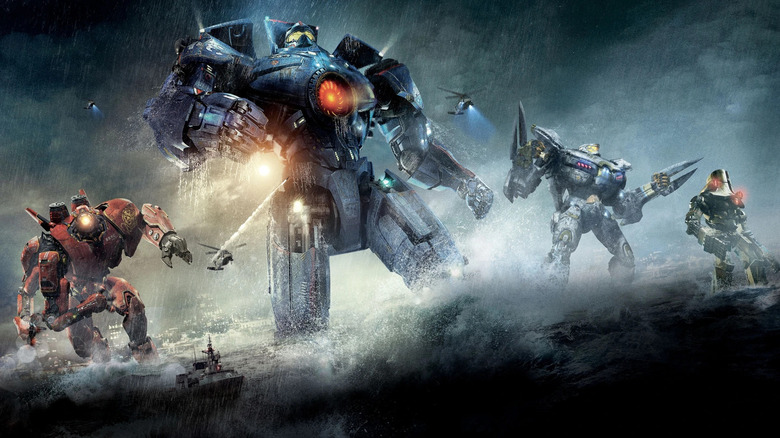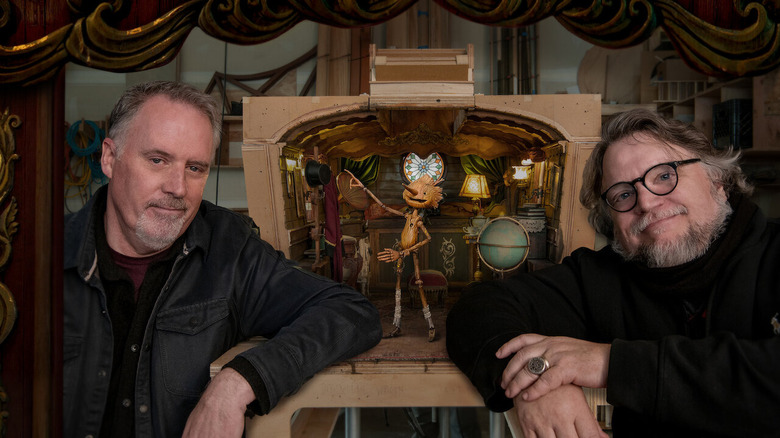Guillermo Del Toro's Pinocchio Sound Designer On Developing The Sounds Of Each Character [Exclusive Interview]
When you're watching Guillermo del Toro's "Pinocchio," the dazzling stop-motion animation will be what first captures your attention. But the film's sound is what accentuates those pictures. "Pinocchio" is del Toro's first musical and his first animated film, so crafting sounds was extra vital.
I spoke with Scott Martin Gershin, the film's sound designer and supervisor. Gershin has previously designed sound for del Toro's films "Blade II" and "Pacific Rim." His résumé also includes "American Beauty," "Nightcrawler," the mini-series "Mrs. America," and video games such as "Gears of War 2" and "Devil May Cry 5." His work on "Pinocchio" has been shortlisted for a Best Sound nomination at the 95th Academy Awards.
During our conversation, we discussed how Gershin and his team developed signature sounds for each of the film's colorful characters. To do so, they had to look at some unexpected sources. He also discussed his goals for the audience reaction when designing the sound of "Pinocchio" and why he shares a creative spirit with del Toro.
Note: This interview has been lightly edited for clarity and brevity.
'I didn't want Pinocchio to sound like five or six or eight different sounds'
To start with Pinocchio himself, obviously he's made of wood, so he's going to sound different than a flesh-and-bone human. What sounds did you use when he's moving about?
The challenge for creating the sound of Pinocchio, and a lot of the other characters as well, is a lot of people are utilizing shoes. Pinocchio's got wood and there's just a lot of wood in the show. So really helping to define [...] characters was a bit challenging and also to make them sound different. For Geppetto and Carlo, we used wood clogs, actually.
I saw some pictures of the look [of Pinocchio], but I didn't have a lot to work with, I had storyboards. So Guillermo and I discussed it, and we tried the obvious, and that is try to find some very old vintage puppets. What we found is the vintage puppets had a certain "clack-iness" to [them] because [they were] quite hard and they tend to be a little bit bigger [...] so when they were banged together to create some kind of movement, it didn't work.
At that time, I started looking for alternative forms of wood to use. I contacted a guitar company called PRS, Paul Reed Smith guitars, because I had this idea of having very exotic musical woods. They sent me 50 pounds of scraps. I ended up cutting that up. That was interesting. So little by little, as I started seeing Pinocchio come alive — not literally like in the movie, but going from storyboards to actual visuals — I started realizing there's a fragility to his movement. At that point, I needed to have a much more looser wood and find ways of making it actually quite agile and smaller-sounding. It wasn't big hits, it was just almost like little jiggles. Then I realized, "Okay, it's just a lot of jiggly wood. How do I give character, how do I give personality?"
So at that point I started noticing nails, the shoulder and stuff. So then I thought, "Okay, let me put some metal squeaks in and let me use creaks so it's not just jiggly hits." So to give it a much [bigger] vocabulary and then choosing what sound at what time to use to best support the character's emotion. At one point, he's in the closet and he's trying to say sorry and he waves to Geppetto and just [squeaking sound]. You just get the nice little squeak.
Finding these wasn't easy. Different things, taking hinges, trying to find different tricks. So it was months and months and months of really experimenting, trying to take organic sounds and to find a way that they would best portray the character. Also, there was a significant amount of manipulation to make the sound's pitch right, squeak right. I mean, I did a lot of manipulating. The whole point of it is I didn't want Pinocchio to sound like five or six or eight different sounds. I wanted it to feel like a single sound and really, really make it tight and have it blend. So in some ways, the audience after while stops listening and just thinks Pinocchio's cute rather than hearing a lot of annoying metal and wood.
'I knew she had to have this otherworldly sound'
I noticed both from what you're saying and in the press release I got, you wanted each character in the film to have distinctive sounds. Can you talk about what sounds you used for each as a supporting cast like Geppetto, or Volpe, or Spazzatura and so on?
So when we were spotting with Guillermo, we came up with that — especially for Volpe, as he walks around, he has two sort of signature sounds. One is that as he walks around or struts, you'll hear money and coins in his pockets. It's very subtle, but it's there if you listen for it. Also, when he's getting very dramatic, we put tap shoes on him, because he is always ready to perform. So he's like "tap, tap, tap..." especially down the stairs. And we have that in about three different areas within the show. We wanted to accentuate his being overly dramatic because he's from the theater.
Podesta was much more subtle and [...] the Priest. We wanted to make the Priest very light-footed, and then we wanted Podesta to be, without going over-the-top, we wanted to give him a heavier authoritarian sound. And so we really worked to get that sound to happen.
I created something cool for what I call "the Sisters," the Forest Sprite and Death. So I had gotten the actress's [Tilda Swinton] voiceover early on and I knew she had to have this otherworldly sound. Maybe it's very highbrow thinking, but when we look at the Forest Sprite, she represents life. So I created the words where they led into her voice ... so I had lead-ins for a lot of specific words. Not all of them. And I did this complex de-tuning with echoes for her voice. When I got to Death, because the Forest Sprite was leading into, AKA life, it was echoing out, so it was sort of the end of life. So I had it before and after highbrow concept.
The whole point is, I needed to make the emotions feel like when he went to see either of them, that they were otherworldly, almost gods and also being omnipresent. So when you hear it in the theater or you hear it in Atmos, it echoes around. So it's not just on the screen, it's everywhere. I came up with this really cool technique to give the voices more sustenance, more sustain, and more echoes, and each word, different echoes are accentuating different words. So I wanted certain words to be heard and accented more than just slapping a plug-in on and just making it happen.
For the enthusiasts who like to do what I do, it's fun to see how we do that. But ultimately, it just has to be right. It has to fit in the pocket. So you go, "Yeah." And that's really what I needed. So when I played it for them the first time, that's what I got. They don't care how I did it, they just want to go, "Does it feel right?" And ultimately, that's the whole show. "Does it feel right? Does each character feel right? Is it too much? Is it too little? Where are those lines?"
'I wanted it to feel a little bit like a kid would go, 'Uh oh''
You mentioned how you did Death's voice. What did you want for the underworld in general? Because that's another otherworldly space and the sounds won't be quite as familiar in the living world.
The otherworldliness of limbo was slowed-down voices. I didn't want it to feel scary, but I wanted to create a certain amount of tension. So, when the big bell hits, when you always hear the death toll ["bell sound"], when the bell rings, I was trying to create something that made you go, "Oh, okay". Especially as a juxtaposition to where the rabbits were, because they're hilarious, they're great. So I wanted it to feel a little bit like a kid would go, "Uh oh," but not enough to be over the top or scary. Then the doors, the doors are massive, and it's the gates of [death], so I wanted to give that a special sound.
When I go to Dogfish, I actually used recordings of inside the body that I had. So it was gurgle-y. And then we had bubbles — some fun little trivia for the bubbles was a lot of the bubble pops I didn't see until we were on the mix stage. So we're like, "Oh, I knew there was going to be bubbles, but I didn't really know much about them."
So I did the typical mud bubbles and when we saw the little scene where Spazzatura pops out of the water and he's inside a bubble, there's a certain impishness, a certain fun-ness. A lot of times, the way we create bubbles is you go into a milkshake and you blow into it. It goes ["bubbling sound"], and it gives a muddy bubble. You can do the same thing with certain oils.
We used all that, but it wasn't quite fun, and Guillermo was like just, "How do we make it more silly without being cartoony?" So yeah, Guillermo and Mark [Gustafson], we put a mic out on the stage and went [mouth pop sound], and just did mouth pops and we started giggling. So we took all the recordings of the mouth pops that everybody did, put it in the scene, and yeah, that's us just doing mouth pops.
'A lot of Dogfish is my voice'
In regards to the Dogfish, that's a series of sounds. I do have a wonderful library, a collection of sounds that I've collected over the years of great creature stuff. But I could create a roar, which for me isn't all that hard, but how do I give Dogfish personality? So to be honest, a lot of Dogfish is my voice. I growled, just started grunting and snarling and vibrating, and put it through some processing to make it big.
Then I needed to figure out how to make him sneeze. The sneeze wasn't the hard part, it's how to make a tickle. So a lot of that is my voice. Then the challenge of that was, it's not a linear time from the beginning when he gets tickled to the time he sneezes. We do a little tickle and then we talk a little bit and then we do more tickling and then his nose grows and we're talking some more. We're waiting until he finally blows him out of his blowhole. So it was a little challenging to find the rhythm to keep it alive, but allow other story points to come through on the lead-up to the blowhole.
Then when we started seeing the visuals, I started seeing the outside of the Dogfish blowholes quivering and I talked to Guillermo, I said, "What about doing a big horn?" We had worked on "Pacific Rim" together and we had done Gipsy [Danger], and I created this giant horn for Gipsy. And he's like, "Yeah, yeah, yeah." But Gipsy's horn was more of a triumphant call to arms. This was something different, but the vibe was still there. It was still a signature. I wanted to make sure that the Dogfish — it's easy to make sound good in the theater because I can rumble the room. I was trying to make sure it sounds good on an iPad. Anyway, so I came up with this sort of chauffeur meets a horn, and all these different horns that I put together to get this [horn sound], so when he was attacking, that was his signature call.
'It's actually not about the individual sound effects'
Cricket, we used some lobster and crab shell. The whole point of it, and the thing I'm most proud about the show, it's actually not about the individual sound effects. I think the two things are that one, when you do a lot of shows you can add a lot of sounds that may or may not get heard. In the sound community, we refer it to as "there's nowhere to hide." Every sound is going to get heard, and there's so much focus on every sound that you have to find the right sound, not just a sound. And a lot of thought and detail went into it and we can hear all the little details, because the visuals are so stunning and are so amazing that I really wanted the audio to compliment the visuals in the same detail that you saw in the visuals.
The other part is that the show, from the way it was designed and the way it was mixed, actually has a full evolution. And very few movies do that. They play the scene, it works, it works and works. We start the show off in mono, and Guillermo wanted it to be a puppet show. So it stays in mono at the very beginning. And then as Pinocchio grows, we start opening it up. So then, when you get to the third act and we have the reeducation camp and we have Dogfish, now you're totally immersed, it's totally enveloping, and we take advantage of the full theater. Then when the show ends, we go back to being mono-ish. And so the mix has a creative arc, and that's unique in a lot of shows.
'[Spazzatura] was all Cate'
I noticed when Pinocchio's nose grows, there's an actual sound effect there. What was the sound effect you used for that? Because it sounded pretty unique, I thought.
Yeah, a lot of it was inspired by the cutting room. Initially, they had these nice little pops [pop sounds] that when it popped, it grew. We ended up using a combination of wood creaks and squeaks. So [creak sound] kinds of sounds. And I really liked what the cutting room sort of did and inspired us to go, "Oh, I like the direction, so now let's make it work." We used a combination of almost tension release pop sounds that really, really helped. And I just want to shout out the crew: Daniel O'Connell doing Foley, Chris Richardson and Andrew Vernon and Tomy Tomita doing sound effects. And then Dan Gamache doing dialogue. And then of course John Taylor and Frank A. Matano doing mixing. Because it was a really good band, it was a good team. I think of everything as music.
I was curious about Spazzatura, did you wind up using any stock monkey sounds for him? Or was that all Cate Blanchett?
No, that was all Cate. I thought we were going to do that. I thought I was going to vocalize her, too, because I can actually match her vocalizations. And Guillermo was like, "No, not going to happen." And then I did a session with Cate. She's fantastic and she had a lot of fun. She just kept laughing the whole time. It was quite silly, in a good way. I thought that she nailed it. We had so many recordings of Cate that we were able to pick and choose, and steal a little bit here and there, to embellish the performances. Because a lot of times, she was initially vocalizing the storyboards, and then when the show became what it was, there were more opportunities, so she just gave us this vast library of great sounds that we were able to take her voice and put them in a number of places. But no, that's all Cate. She's great. By the way, she not only did the monkey sounds, but the three puppets that keep talking. That's Cate. I think all the actors did an amazing job. I've worked with Cate before and she always impresses. I think all of the actors just had a little something going on that just jumped off the screen. Usually, there's always a couple, but I think everybody knocked it out of the ballpark and I think they capture some magic, especially for the [actor] who plays Pinocchio [Gregory Mann].
'You stop thinking of it as animation or stop motion and it starts feeling more like production'
In your experience, what's the difference between designing sound for a live-action film and designing for an animated film?
In live-action films, there's a certain amount of production. There is a little bit of air, a little bit of noise that plays into a microphone. So you have a little bit of depth of field and you have what we just call production noise. There is none of that in this, and not only is there no production noise, but they're always stagnant in front of a mic. So if [their characters are] moving across a room or they're far away and then come up close up, they're always at the same point on that mic. So it could create a very flat dialogue response. I think John Taylor did an amazing job of giving us some depth of field. So we have to take each word of dialogue and sort of place it within the scene and within the depth in which they're in.
But at the same time, it's not formulaic, because sometimes there'll be a shot where Pinocchio with Geppetto is distant and then they're close. If we cover that, sometimes it sounds great. Other times, we just accentuated a cut that we didn't want to do. So we had to choose in any given moment, "Does that work emotionally, even though it'll work literally?" And there were discussions throughout the show of, "Let's not point out that we just did a cut [or a] camera perspective change, because we don't want to accentuate that." And other times, "No, no, no, different characters are in different places in the room. Let's build that depth of field to really make it feel like production." And I think the more we make things sound like production, from manipulating the dialogue to having the right movements in foley and treating that correctly, you stop thinking of it as animation or stop motion and it starts feeling more like production.
So we have to create every background, every little noise nuance. Something that Guillermo said and was very inspiring, when you look at the film, the animation and the movements are epic. What I mean by that is, it's not just somebody sitting in a chair. They come in a chair and then they scoot a little bit. All of their movements have a human factor to it because not everybody is exactly robotic. There's always a little subtle, a little thing, a little nudge, and all these little human imperfections that he wanted to capture that actors would capture in the live performance, but animation would many times not think of because it's an extra little something. So it's a little imperfection. We wanted to do the same thing with audio, too. Just have these little humanistic sounds to compliment what we were seeing.
I think what makes the show special for me and harder — Guillermo goes, "Ah, this shouldn't be too hard for you," and I'm like, "It's a different set of challenges." Because before, I spent a lot of my career making things sound big and cool. This is all about minimalistic, delicate, little sounds, and it's amazing how you think, "Oh, I'll take this, I'll put that there." And it doesn't work. You find all these things that don't work until you find the right sound, then you go to the next sound. This one I found quite challenging to get it to the point that I wanted it to and to get it to the point where I felt it equaled the visuals.
'We just have this creative connection that I think just really works'
I'm a big del Toro fan, if you haven't guessed already. What is it like working so closely with him? And since you've worked with him before, how has it been different?
When I started with Guillermo, it was on "Blade II' and he used to call me saying, "Hey, you want to go to a movie and grab some ribs?"
Sounds like a fun night.
Yeah, it was good. So we've worked together a long time and the only way that I can equate it is like being in a band. Why do two musicians get along, and how does the magic happen? I think we have similar tastes, I think we have similar approaches. I think I was able to connect. We don't even need to talk as much. He hates to use words. He would rather me just put sounds there and then he can talk about the sounds and does it have a feel? Does it not?
I'm able to get most of the sounds where he wants it because I think I've got to go with my taste, which happens to be very similar to his taste. I think it's a combination of him inspiring me and me inspiring him, and we just have this creative connection that I think just really works. I find him incredibly inspiring. I've always been — I'm also a fan and I think when I work with him, it's not that you want to work better, but there's a certain energy that makes you want to just push it further. And it's hard to describe when a person has more of that or less of that.
I love his shows. I think it's because I'm inspired by the visuals. I'm such a fan of what he's doing that it just makes me feel like I've got to work that much harder because he is. And he works hard, so I've got to work just as hard.
"Pinocchio" is now streaming on Netflix.
